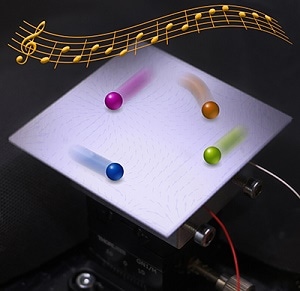Sep 12 2016
 Credit: Quan Zhou
Credit: Quan Zhou
A team of researchers from Aalto University have successfully manipulated the motion of many objects on a vibrating plate with a solitary acoustic source. By playing meticulously composed melodies, the researchers could concurrently and separately move a number of objects on the plate towards preferred targets. For instance, the team were able to write words comprising of individual letters with movable metal pieces on the plate by playing a tune.
Ernst Chladni - the father of acoustics - conducted the first studies of sand moving on a vibrating plate in 1878. Chladni discovered that when the plate was vibrated at a frequency, objects move towards a few positions, known as the nodal lines, particular to that frequency.
Since then, the established view has been that the particle movement is unsystematic on the plate prior to reaching the nodal line.
We have shown that the motion is also predictable away from the nodal lines. Now that the object does not have to be at a nodal line, we have much more freedom in controlling its motion and have achieved independent control of up to six objects simultaneously using just one single actuator. We are very excited about the results, because this probably is a new world record of how many independent motions can be controlled by a single acoustic actuator.
Professor Quan Zhou, Aalto University
The objects to be manipulated have been kept on top of a manipulation plate, and imaged using a tracking camera. Based on the identified positions, the computer shuffles through a list of music notes to locate a note that is most likely to move the objects towards the preferred directions.
After playing the note, the new positions of the objects are identified, and the control cycle is started again.
This cycle is performed again and again until the objects have reached their preferred target locations. The notes played during the control cycles create a sequence, similar to music.
The new technique has been applied to influence an extensive range of tiny objects including water droplets, electronic parts, candy balls, plant seeds, and metal parts.
Some of the practical applications we foresee include conveying and sorting microelectronic chips, delivering drug-loaded particles for pharmaceutical applications or handling small liquid volumes for lab on chips. Also, the basic idea should be transferrable to other kinds of systems with vibration phenomena. For example, it should be possible to use waves and ripples to control floating objects in a pond using our technique.
Professor Quan Zhou, Aalto University
The research paper has been published in Nature Communications.
Dances with waves: breakthrough in moving small objects using acoustics
Video Credit: Aalto University/Youtube.com